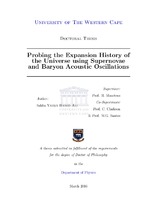Probing the expansion history of the universe using upernovae and Baryon Acoustic Oscillations
Abstract
The standard model of cosmology (the ɅCDM model) has been very successful and is compatible with all observational data up to now. However, it remains an important task to develop and apply null tests of this model. These tests are based on observables that probe cosmic distances and cosmic evolution history. Supernovae observations use the so-called `standard candle' property of SNIa to probe cosmic distances D(z). The evolution of the expansion rate H(z) is probed by the baryon acoustic oscillation (BAO) feature in the galaxy distribution, which serves as an effective `standard ruler'. The observables D(z) and H(z) are used in various consistency tests of ɅCDM that have been developed. We review the consistency tests, also looking for possible new tests. Then the tests are applied, first using existing data, and then using mock data from future planned experiments. In particular we use data from the recently commissioned Dark Energy Survey (DES) for SNIa. Gaussian Processes, and possibly other non-parametric methods, used to reconstruct the derivatives of D (z) and H (z) that are needed to apply the null tests of the standard cosmological model. This allows us to estimate the current and future power of observations to probe the ɅCDM model, which is the foundation of modern cosmology. In addition, we present an improved model of the HI galaxy number counts and bias from semi-analytic simulations, and we use it to calculate the expected yield of HI galaxies from surveys with a variety of phase 1 and 2 SKA configurations. We illustrate the relative performance of the different surveys by forecasting errors on the radial and transverse scales of the BAO feature. We use the Fisher matrix method to estimate the error bars on the cosmological parameters from future SKA HI galaxy surveys. We find that the SKA phase 1 galaxy surveys will not contend with surveys such as the Baryon Oscillation Spectroscopic Survey (BOSS) whereas the full "billion galaxy survey" with SKA phase 2 will deliver the largest dark energy Figure of Merit of any current or future large-scale structure survey.

